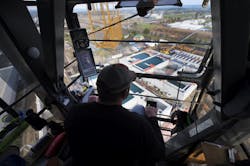PHOTOS: Intel's largest water recycling plant
HILLSBORO, OR, APRIL 23, 2018 -- Intel's huge water recycling plant, now under construction in Hillsboro, Oregon, is a key step toward meeting the company's long-term water reduction and recycling goals.
Intel is reducing the water it uses in computer chip manufacturing. It also has set a 2025 worldwide goal to return 100 percent of its water to communities and watersheds for local use. Over the past 20 years, Intel has conserved about 60 billion gallons of water.
When the three-year Hillsboro project is complete, the facility will be able to recycle about 1 billion gallons of water every year – the equivalent of 90,000 Olympic-size swimming pools. The plant will be Intel's biggest water recycling facility in the world.
When Intel's three-year water recycling plant construction is completed, crane operator Darren Starks estimates he'll have spent a full year working from his tiny office-in-the-sky. Much of his time, says Starks, he is "fighting the wind" as he slings construction gear around the Hillsboro, Oregon, site. Any nervous moments 150 feet off the ground? Sweaty palms? "Never," he says.
Credit: Walden Kirsch/Intel Corporation
From inside his cab 150 feet above the Hillsboro, Oregon, job site, crane operator Darren Starks looks down on Intel's under-construction water recycling plant. Starks can hoist skyward up to 40 tons at a time, and on a busy day is responsible for about 80 lifts of construction equipment, piping and other gear. When the recycling plant is completed, it will help Intel cut its manufacturing water use. Intel has set a goal to return 100 percent of its water to communities and watersheds for local use by 2025.
Credit: Walden Kirsch/Intel Corporation
The Liebherr 630 construction crane that towers over Intel's water recycling project in Hillsboro, Oregon, is visible for miles. Darren Starks climbs the 150-foot metal ladder once a day – up in the morning, down in the afternoon.
Credit: Walden Kirsch/Intel Corporation



